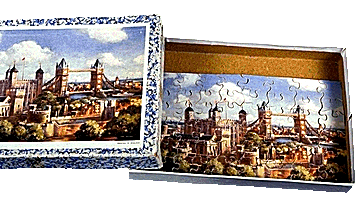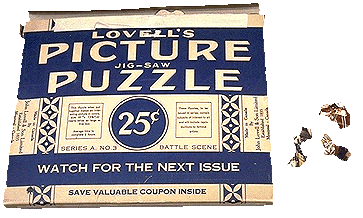Since the 19th Century puzzle makers have used historical events and subjects for jigsaw puzzles. Here are two examples from the collection.

This puzzle was donated to the Museum in 1982. It was purchased by the donor in England in the 1950s. The box offers no printed information about the puzzle. The puzzle is composed of 50 pieces.
Martin Norgate, Registrar, Hampshire CC Museum Service, Winchester, UK, identifies this puzzle as one of a series made by G.J. Hayter & Co., Boscome, Bournemouth, Dorset, UK, and marketed under the series title "Victory Puzzle".
Norgate indicates that the illustration dates from the first half of the 20th century, but this is not indicative of when the puzzle was producted, nor what event it is intended to commorate. He does indicate however, that this puzzle is a typical example of Hayter's product and packaging.

This puzzle is one of a series of four jigsaw puzzles purchased by the Museum in 1982. Manufactured by John Lovell & Sons Limited, Montreal, Canada, each puzzle comes in a similar soft cardboard box. The subject matter of each puzzle is an event in Canadian history when Canada was part of the British Empire. Of the four, two boxes are printed in blue, and two boxes are in green.
The pictured example indicates that the puzzle is "Series A - Number 3". The box which opens at each end is 1.9cm thick x 25.3cm wide x 20.3cm high. The puzzle itself is composed of 95 non-interlocking pieces (examples in the photo on the left) which form a 35cm x25.4cm rectangle. The 196 pieces are 3cm thick and are composed of printed paper pasted on thin cardboard. The puzzle picture is of a battle scene betwen two armies, one army in red uniforms, with guns, bayonettes, swords, and the British Flag. The other army is in blue uniforms. Dead soldiers are pictured on the ground.
In trying to determine the age of these puzzles, it has been suggested that they were manufactured in the late 1930s or early 1940s - the World War II period - when there was a shortage of cardboard for rigid outer boxes.
It has also been suggested that these puzzles might have been intended as an inexpensive item, and were packaged this way to limit costs. Williams indicates that these may be examples of a weekly series of puzzles which were published during the "depression years" as inexpensive adult home entertainments.
Last update April 3, 2010